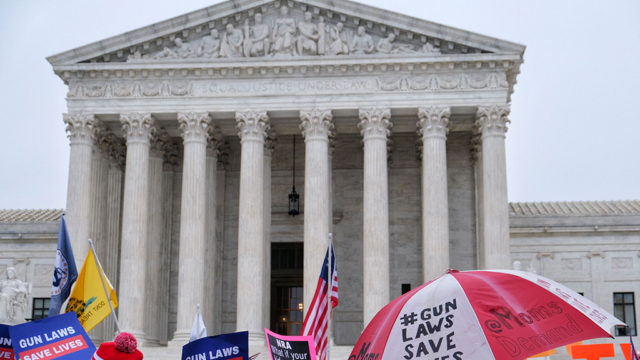
The Supreme Court is set to hear oral argument in the United States v. Cargill case on Feb. 28, 2024. Here’s what you need to know.
What’s the question?
The case asks if bump stocks can be categorized as machine guns under a rule issued by the Bureau of Alcohol, Tobacco, Firearms and Explosives (ATF).
During the administration of former President Trump, ATF clarified the definition of a machine gun under the National Firearms Act—in effect barring civilians from purchasing and possessing these dangerous devices. The United States v. Cargill case weighs whether ATF’s interpretation of the law was the best interpretation of the National Firearms Act.
What is a machine gun?
Under the National Firearms Act, a machine gun is “[a]ny weapon which shoots, is designed to shoot, or can be readily restored to shoot, automatically more than one shot without manual reloading, by a single function of the trigger.”1 26 U.S.C. § 5845(b), ATF National Firearms Act Definitions, https://www.atf.gov/firearms/firearms-guides-importation-verification-firearms-national-firearms-act-definitions, accessed Jan. 25, 2024 Depending on the make and model of the machine gun, it can fire anywhere from several hundred to several thousand rounds of ammunition per minute.
AR- and AK-style rifles (sometimes referred to as “assault weapons”) are presently configured to fire semi-automatically, requiring a separate pull of the trigger for each round of ammunition fired. When equipped with large-capacity magazines and bump stocks, an AR- or AK-style rifle can fire up to 800 rounds per minute.
What’s the context?
In 1934, Congress passed the National Firearms Act, federal legislation that tightly regulated the sale of machine guns. Further legislation in 1986 prohibited civilians from owning newly manufactured machine guns, including any device that converts a firearm into a machine gun. A bump stock qualifies as a machine gun because, when a shooter outfits an assault weapon or other semi-automatic weapon with a bump stock, it becomes a functional machine gun—and can fire hundreds of bullets a minute with a single pull of the trigger.
Machine guns have been tightly regulated under federal law for 90 years. The gun industry invented bump stocks to skirt federal law and make assault weapons even deadlier.
What are bump stocks?
Bump stocks are so-called “conversion devices” for semi-automatic AR- and AK-style rifles—effectively allowing these rifles to fire like machine guns—that harness the gun’s recoil to increase its rate of fire to up to 800 rounds per minute. Bump stocks were designed to mimic automatic gunfire while evading the laws that ban machine guns.
In 2017, Americans witnessed just how damaging guns equipped with bump stocks can be when a gunman, wielding 14 rifles outfitted with bump stocks, killed 60 people and wounded at least 411 more at the Las Vegas Route 91 Harvest Festival—the deadliest mass shooting in modern American history.
After this shooting, ATF went through a rulemaking process to reevaluate its interpretation of whether bump stocks were considered machine guns. It then finalized a rule to prohibit the production, sale, and possession of bump stocks, clarifying that it interprets federal law to require classifying bump stocks as machine guns because, when attached to a semiautomatic firearm, a bump stock allows a shooter to continuously fire a weapon “with a single pull of the trigger.” [emphasis added]
How do bump stocks work?
Rifles are designed to be fired with their stocks resting against a shooter’s shoulder. A bump stock is a replacement shoulder stock for a semi-automatic rifle that allows the gun to slide back and forth within the stock. To fire, the shooter holds the bump stock against their shoulder while keeping their trigger finger stationary on the bump stock’s “trigger ledge.” The shooter then grips the front half of the rifle as they normally would and pushes forward until their trigger finger engages the trigger.
After firing one shot, the rifle reciprocates into the bump stock and returns forward to “bump” into the shooter’s stationary trigger finger to fire again and again. The shooter doesn’t have to move their finger continuously to keep firing, but rather can simply hold their finger steadily in place. This is known as “bump firing.”

Immediately after ATF finalized this lifesaving new rule, the gun lobby filed suit to block it. Though two federal appeals courts upheld the rule, extremist judges on the Fifth Circuit Court of Appeals eventually struck it down, effectively legalizing bump stocks in Texas, Louisiana, and Mississippi. Now, the Supreme Court of the United States has agreed to take up the case—and could open the door for these deadly accessories to be legalized once again in a majority of states across the country.
What’s the case?
In April 2018, case defendant Michael Cargill bought two bump stocks. He did so legally, as ATF had not yet finalized its rule clarifying that bump stocks are machine guns, thereby prohibiting the production, sale, and possession of bump stocks.
After ATF officially established this rule, Cargill “‘surrendered [his bump stocks] to ATF on March 25, 2019’”—as he was obligated to do per ATF’s rule. On that same day, Cargill challenged ATF’s rule in the Western District of Texas.
Both the district court and three judges on the Fifth Circuit Court of Appeals upheld that “‘bump stocks qualify as machine guns under the best interpretation’” of ATF’s rule. However, after the case was reheard by the Fifth Circuit en banc (i.e., by a full panel of appeals court judges), the decision was reversed.
Why is it being heard by the Supreme Court?
Last January, the Fifth Circuit Court of Appeals—the gun lobby’s favorite federal appeals court—struck down ATF’s life-saving rule on bump stocks, ruling that ATF did not have the authority to issue the rule. The ruling effectively legalized bump stocks in Texas, Louisiana, and Mississippi. The ruling also conflicted with the rulings of other federal courts of appeal.
This is yet another example of extreme judges ruling to strike down life-saving laws and regulations around gun violence prevention.
Bump stocks are devices that are designed and intended to convert semi-automatic firearms into machine guns.
By clarifying that bump stocks are machine guns, ATF is properly interpreting federal law and vindicating the purpose of the National Firearms Act—a law that has been on the books for decades to protect Americans from deadly machine guns and other of the most dangerous weapons.
Reminder: The National Firearms Act defined a machine gun by whether multiple bullets could be fired “by a single function of the trigger.” The ATF rule simply clarifies that—consistent with this definition—a bump stock is a machine gun because it allows a weapon to fire multiple bullets by a single pull of the trigger. The Fifth Circuit Court of Appeals argued in its reversal that the National Firearms Act “does not care what human input is required to activate the trigger—it cares only whether more than one is fired each time the trigger acts.”
The difference in interpretation is that the trigger repeatedly releases and resets when acted upon by a bump stock, even though a person using a bump stock manually pulls the trigger only once—and then holds their finger in place.
Now, the Supreme Court will rule on whether ATF properly applied the National Firearms Act to regulate bump stocks.
What’s at stake?
Right now, bump stocks are legal to sell and possess in the states under the purview of the Fifth Circuit Court of Appeals: Texas, Louisiana, and Mississippi. How the Court decides in United States v. Cargill could determine if these deadly accessories will once again flood our streets across the country.
If the Supreme Court rules to uphold the Fifth Circuit’s extreme decision to effectively legalize bump stocks, that decision will invalidate ATF’s rule preventing the manufacture, sale, and possession of bump stocks.
If this happens, any states that do not have their own laws on the books restricting bump stocks would immediately find that bump stocks are legal—and people could easily turn their assault weapons into functioning machine guns. If the Supreme Court sides with the Fifth Circuit, bump stocks will automatically be legalized in as many as 36 states.
Bipartisan support
Outlawing the production, sale, and possession of bump stocks isn’t just common sense, it’s bipartisan. Following the Las Vegas mass shooting—the deadliest by a single perpetrator in our nation’s history—the Trump Administration took action to ban bump stocks, directing ATF to issue a rule making clear that bump stocks are illegal.
In addition to movement from the Trump Administration, Republican governors in Massachusetts, Florida, Maryland, and Vermont signed legislation following the Las Vegas shooting to ban these deadly accessories of war.
Even the NRA supported greater restrictions on bump stocks, but other gun groups filed suit to block ATF’s measure.
Now, the Supreme Court has agreed to take up the case, potentially opening the door for these deadly accessories to be legalized once again in a majority of states across the country.
Join the Courts Advocacy Team
Be the first to know when the Supreme Court rules on this case, and learn how we’re fighting back against the gun lobby. Click here to join the Everytown Courts Advocacy Team to stay updated on major decisions that impact gun safety laws.
The Latest

What Are Moms Demand Action Advocacy Days?

Ahead of Trans Day of Visibility, Three Advocates Share What Gives Them Hope

“Texting Is an Integral Part of the Gun Violence Prevention Movement”





